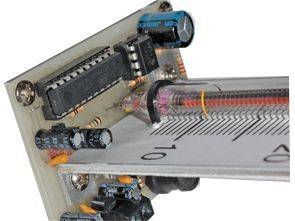Summary of NIXIE TUBE THERMOMETER CIRCUIT
This article describes a Nixie lamp thermometer project using an ATtiny2313 microcontroller and a DS18B20 temperature sensor. The DS18B20 provides 12-bit resolution temperature readings every 2 seconds, with valid readings constrained between +10°C and +44°C to avoid errors. The ATtiny2313 runs at 1 MHz and controls the display and measurement processes. The circuit includes a MC34063 voltage inverter to supply the high voltage needed for the Nixie tubes, with a MOSFET transistor and other components managing energy storage and voltage stabilization.
Parts used in the Nixie lamp Thermometer DS18B20 Circuit with ATtiny2313:
- ATtiny2313 microcontroller
- DS18B20 temperature sensor
- MC34063 voltage suppressor inverter
- MOSFET transistor T1
- Gate-stop resistor R3
- Inductor/choke L1
- Diode D1
- Capacitor C7
- Voltage regulator U1 (for 5 V stabilization)
Nixie lamp Thermometer DS18B20 Circuit with ATtiny2313 The first Nixie lamps appeared in the mid-twentieth century. For many years they have been used in a variety of apparatuses but have been supplanted by newer… Electronics Projects, Nixie Tube Thermometer Circuit “avr project, microcontroller projects, “
Nixie lamp Thermometer DS18B20 Circuit with ATtiny2313 The first Nixie lamps appeared in the mid-twentieth century. For many years they have been used in a variety of apparatuses but have been supplanted by newer VFD displays and LEDs. For decades, forgotten again, they returned to grace in retro electronics projects of hobbyists as well as a wider audience thanks to increasingly popular commercial projects. The digital sensor measures the temperature with a resolution of 12 bits and a frequency of 0.5 Hz (every 2 seconds). In order to eliminate possible sensor errors, a range of accepted temperatures has been introduced from + 10 ° C to + 44 ° C. All values outside the range are considered erroneous and are not considered.
NIXIE THERMOMETER CIRCUIT DIAGRAM
The Nixie thermometer schematic diagram is shown in Figure 1. The heart of the circuit is the ATtiny2313 microcontroller running on an internal RC oscillator with a frequency of 1 MHz. As a temperature sensor, the popular DS18B20 chip is used to measure from -55 to 125 ° C with a maximum resolution of 12 bits. The U1, together with the set of external components, stabilizes the 5 V voltage used to power the digital part of the thermometer.
Due to the high flash voltage of the lamp, the MC34063 voltage suppressor inverter was used. The MOSFET T1 transistor, along with the gate-stop resistor R3, acts as a key. During conduction of the transistor the L1 choke stores the energy in the form of a magnetic field, and the diode D1 is polarized by blocking the C7 capacitor before discharging.
Source: NIXIE TUBE THERMOMETER CIRCUIT


